The tropical forests of equatorial Africa are home to gorillas, known to be great herbivorous apes that dwell most of their time on the ground.
Known to be part of two species, Western and Eastern gorillas, they are among the strongest living primates on earth, pound for pound, concerning their size and strength. But exactly how strong is a gorilla?
According to Guinness World Records, a gorilla has lifted 1,800 pounds of weight, has a bite force of 1300 PSI, and many theories contend that gorillas can lift ten times their weight. For perspective, the average male human can only lift 0.87 times their body weight.
Once fully grown, the average male mountain gorilla can grow to be 5.5 feet (170 cm) tall on all fours and weigh around 396 pounds (180 kg) on average. Still, researchers have found it difficult to quantify the exact strength of gorillas.
With that in mind, let’s take a closer look at what makes a gorilla so powerful.
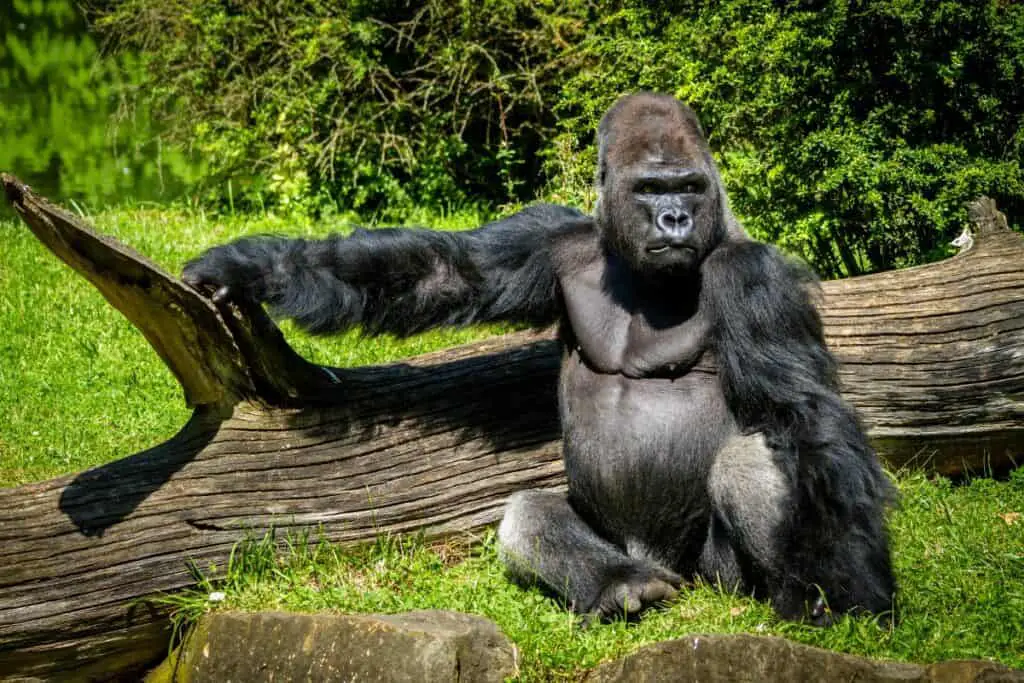
- Measuring The Strength Of A Gorilla
- How a gorilla’s diet contributes toward its strength
- A gorilla’s bone size defines its muscle mass
- What is the strength of a gorilla’s bite?
- How gorilla’s shape contributes to its strength
- How gorillas manage to carry their weight on their knuckles
- The social and defensive behavior of gorillas
- How gorillas respond to threats
- Gorillas vs. their natural enemy: Leopards
- Final thoughts on the strength of gorillas
Measuring The Strength Of A Gorilla
The strength of a silverback gorilla is undoubtedly impressive. Because of the silver saddle of hair on their backs, adult male mountain gorillas (a subspecies of Eastern gorillas) are known as Silverbacks.
Mountain gorillas have broad chests, long, muscular arms, and wide feet and hands. They also have a stocky build.
Even though they share 95 to 99% of DNA with humans, a gorilla would probably be the worst opponent you could choose if you could face any animal in a strength-measuring contest. And to back that up, the following are just a few interesting facts.
- A gorilla’s estimated strength (force exerted by action) is approximately six times that of a human.
- The weight of a male gorilla can range from 135 to 225 kilograms or 300 to 500 pounds.
- They can bite at 1,300 pounds per square inch (PSI), with more force than a lion, and are similar to bull sharks.
- Gorillas can sprint at speeds of up to 20 to 25 miles per hour but can not hold that speed for extended periods.
- They can out-reach almost any human with an arm span of between 7.5 and 8.5 feet (2.3 and 2.6 meters).
- Besides fangs, gorillas are more stable and effective fighters than humans because they have a lower center of gravity.
With those stats in mind, you don’t want to go against a gorilla. It’s interesting to note that silverback gorillas are not particularly interested in fighting you unless you provoke them by challenging or invading their territory.
Although gorillas are omnivores, most of their diet comprises plant matter. They only consume a small amount of protein from insects like termites and ants. Gorillas in captivity consume only vegetables, including leafy greens like kale and lettuce, carrots, celery, zucchini, and fruit like apples or oranges.
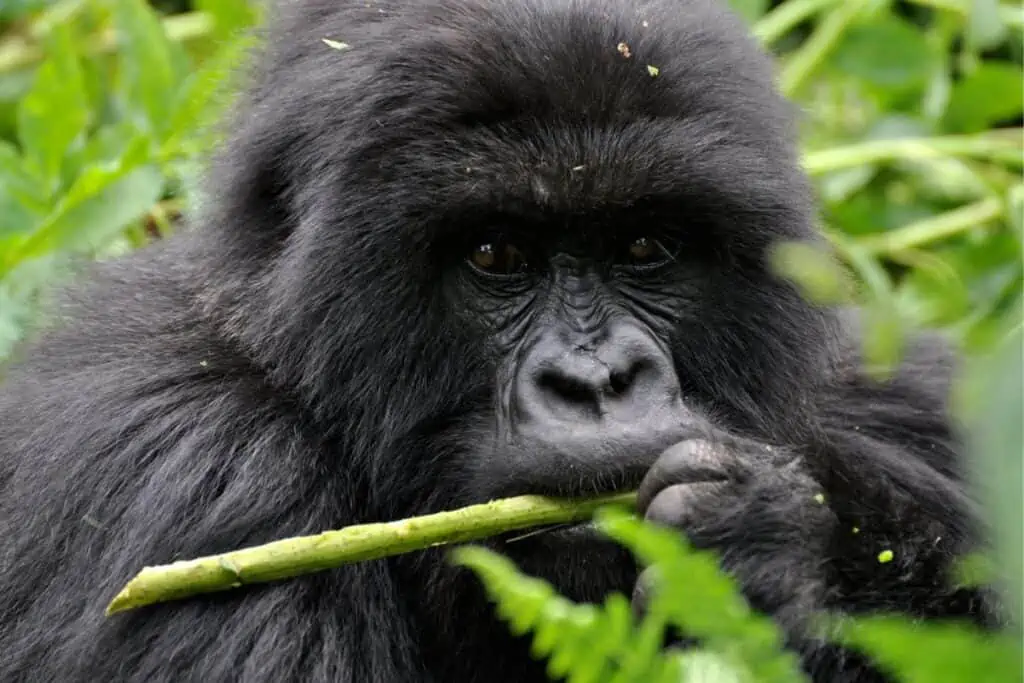
Protein powder, beef, chicken, or any other sources of high-density protein were excluded from that diet. So, those insects mentioned earlier conclude only up to 3% of a gorilla’s diet, even in the wild.
Organic, highly nutritious, low-fat, high-energy ammunition drives the enormous gorilla engine. That said, you would be interested in finding where the source of a gorilla’s strength originates.
How a gorilla’s diet contributes toward its strength
A gorilla’s stomach, or just a little lower down, is the key to its power. If you’ve ever seen a gorilla in a zoo, you may have noticed that they have a large, bulky potbelly.
To give their gut microbiome enough time to do its magic, gorillas have more prominent, longer intestines, which account for their bulky stomach.
A substance called “cellulose” is the secret ingredient gorillas ingest, which their microbiome uses. These are numerous, lengthy, linear lines of glucose molecules that resemble metal chains in their connection.
Cellulose, which makes up the cell wall encloses each plant cell, gives plants their rigidity and structure.
Of course, cellulose does not turn into protein. But it does give bacteria something to eat.
As a result, the bacteria become protein-rich little bubbles floating in the digestive system, waiting to be absorbed. Unlike people, Cows also follow a similar digestion process involving different levels of gut fermentation, so this is not a gorilla-specific process.
Without any weightlifting or any other muscle-focused training involved, the procedure for a gorilla to gain weight and develop that bulky body is as follows:
- By consuming a lot of plant material, including cellulose.
- Allowing their gut bacteria to use the cellulose as a food source as they break it down.
- Absorbing the protein from the bacteria.
Continuous gathering and consuming up to 40 lbs (20 kg) of food is required daily. All this hard work is possible because the fuel in this enormous gorilla engine is an organic, highly nutritional low-fat, high-energy food intake.
A gorilla’s bone size defines its muscle mass
Although diet is an essential factor, the gorillas’ bones’ size and bone structure also form the basis of their strength.
When you compare the skeletons of humans and gorillas, you’ll find that gorillas have bones that are 2-3 times larger than humans, allowing them to develop much larger ligaments and muscles.
Gorillas have a distinctive and sturdy biological nature. The arms of a gorilla are powerful and considerably longer than its legs. Gorillas have been observed to climb trees and swing from limbs while walking on all fours. They exercise their arms a great deal each day as a result.
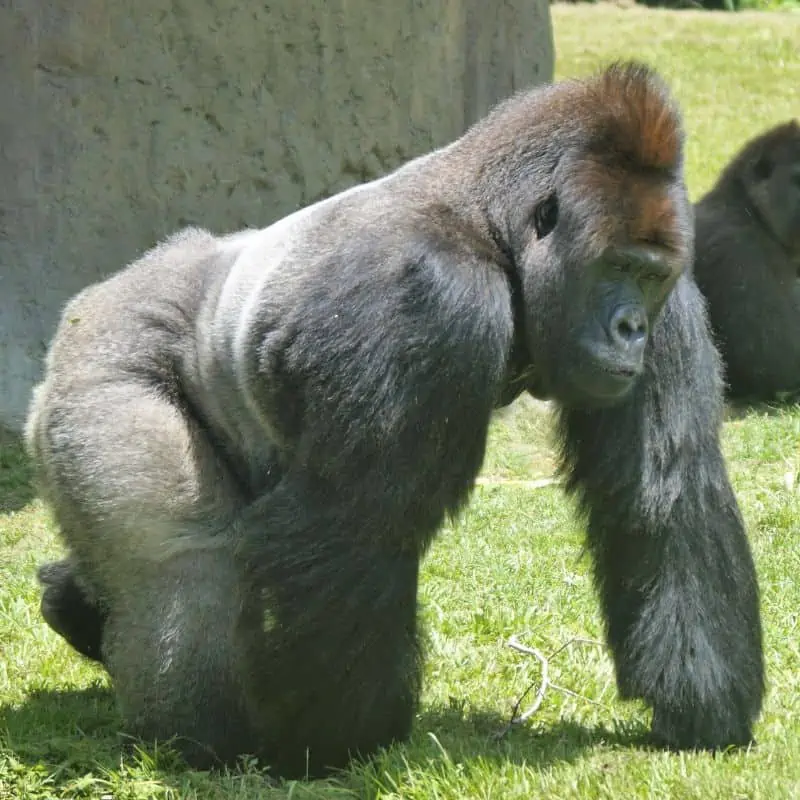
These giant apes can climb and swing even though they weigh a lot, demonstrating the tremendous strength in their arms.
Furthermore, gorillas are four to nine times as strong as the average person. For instance, a male silverback can lift 1800 lbs (815 kg) of dead weight, whereas even professional weightlifting individuals can only lift 900 lbs (410 kg), which is only half as much as the ape. As a result, most professional fighters pale compared to an average silverback.
The fact that their muscles are not only large but also that their muscles are composed of red muscle fibers, which allows for more oxygen to be carried, leads scientists to believe that gorillas may be able to surpass their current records for strength.
What is the strength of a gorilla’s bite?
Based on all the above information, you won’t want to take another bite from this cautious giant after the first.
The creatures we fear the most when we imagine being bitten include lions, crocodiles, and sharks. These are the kinds of terrors that have razor-sharp teeth and monstrously giant mouths in common.
The silverback gorilla has a weapon it can reserve for emergencies and boasts a bite force of 1300 psi. In contrast, bull sharks can exert a bite pressure of 1350 psi while lions can only produce 650 psi.
As a result, even though you may consider gorilla strength in terms of how much they can lift or move, these rainforest giants also have one of the world’s most powerful bites.
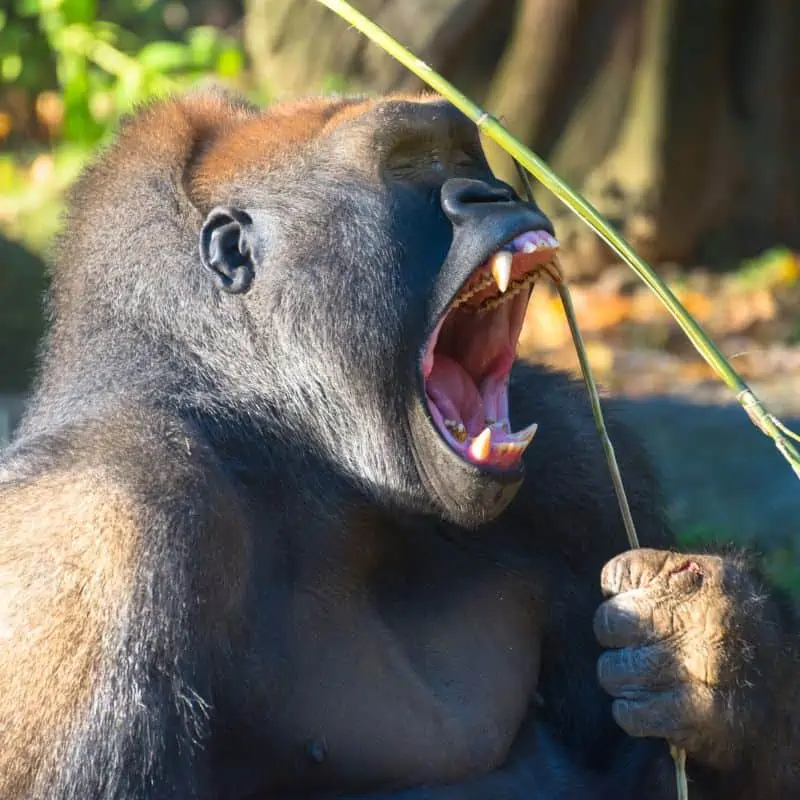
How gorilla’s shape contributes to its strength
While comparing gorillas to humans can be helpful as a point of comparison, we must never forget that a silverback’s musculature and skeleton are significantly more robust.
They also have different body shapes, balances, mobility, and abilities. As a result, gorillas are more suited than humans to carry out specific movements with greater strength.
However, comparing gorilla strength to that of humans doesn’t make sense; for example, even though their arms are capable of lifting enormous weights, they lack the necessary balance.
Unlike humans, gorillas have larger arm muscles than leg muscles and often use their more muscular arms for defense, bending, and gathering foliage. Even though they can stand on two feet, they typically walk as a quadruped (on four limbs).
The arm span of a gorilla is about one foot (30 cm) longer than that of an adult male human. Gorillas’ arms are also much longer than their legs.
Despite the gorillas’ predominant terrestrial lifestyle (ground dwellers), their elongated arms suggest a tree-dwelling ancestry, which is why they can launch themselves from trees or the ground more quickly, complimenting their form and posture.
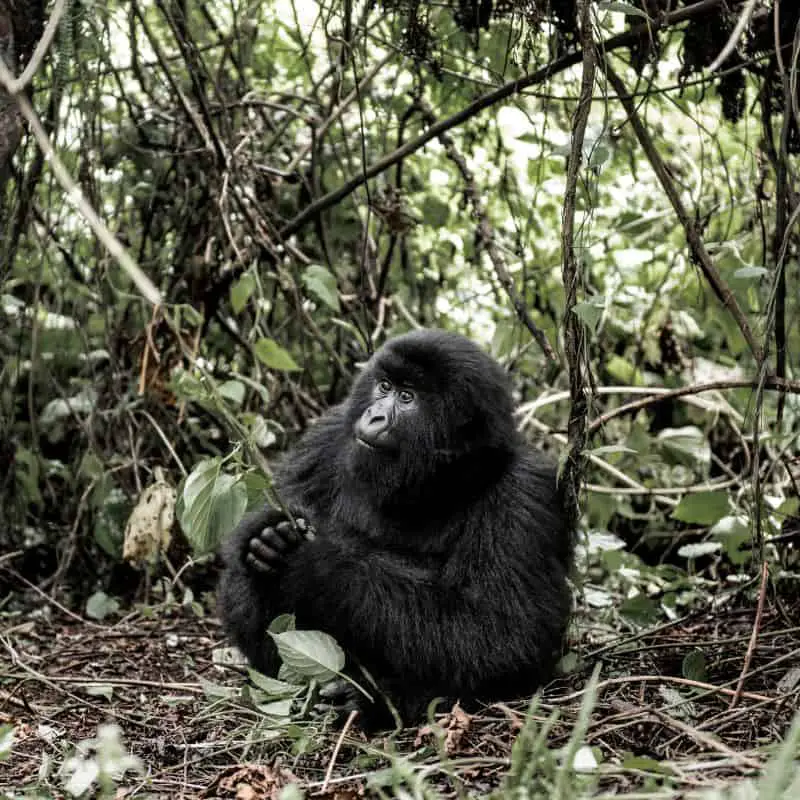
How gorillas manage to carry their weight on their knuckles
Gorillas are competent knuckle-walkers. It isn’t because they can’t support their weight in an upright position; they can travel on two legs when required.
Instead, gorillas have different adaptations for mobility and weight-bearing as being knuckle-walkers.
A cupped, downward-facing end of the radius in the forearm fits snugly beside the scaphoid in the wrist on the forearm’s end closest to the hand.
Their knuckle bones (metacarpals) have ridges that ‘lock’ into position with their finger bones (phalanges), and the skin on their fingers are thick and heavily padded.
The middle and end phalanges, which bear the animal’s weight, are widened and flattened.
The hands and wrists of a gorilla are sturdy, robust parts that can support up to a 500-pound silverback male.
The social and defensive behavior of gorillas
Gorillas live in non-territorial groups known as troops, including 1 to 4 adult males (referred to as silverbacks), a few juvenile males (referred to as blackbacks), several adult females, and young.
Since silverbacks are in charge of ensuring the troop’s security, even when resources are scarce, the silverback controls all group decisions. They make most of the calls, get most of the food, and have the strength to stop disruptive behavior among the troops with just a glance.
Before acquiring his troop, a male must have a well-defined home range and great strength to face any rival. As a result, most silverbacks typically live alone until they are 15 years old before joining a troop of their own.
Adult females are not bound together and frequently compete in grooming and maintaining proximity to the silverback. For the first three years of life, mothers and their children form a close bond.
The fierce competition for adult females frequently leads to combative interactions between a dominant and a rival silverback trying to establish or grow a troop. These altercations occasionally last for days and may involve every troop member.

How gorillas respond to threats
The troop’s defense and security are the responsibility of the dominant silverback.
The silverback will ferociously beat its chest, emit loud scowling vocalizations, discharge a pungent odor that humans can smell from more than 25 yards away, throw vegetation, and charge at its adversary or intruder in a threatening situation.
According to research, most silverback-threatening charges are bluffs, giving the rest of the troop time to flee to safety.
The silverback will, however, carry out his threat if pushed. Finally, protecting the young is also aided by mothers and older siblings.
Gorillas vs. their natural enemy: Leopards
In some parts of Africa, leopards and gorillas roam in the same terrain. They can efficiently dispatch humans and animals with unmatched power, speed, and natural weapons for attack and defense.
Compared to some hypothetical encounters between animals, a leopard is known to prey on smaller and infant gorillas.
Leopards and gorillas differ significantly in their body types, sizes, and speeds. However, when it boils down to a showdown between a silverback gorilla and a leopard, the outcome may change on various factors.
However, based on five features: Speed, Size, Senses, Combat Skills, and Defence, let’s take a closer look at what the results may prove.
1. Speed
Gorillas cannot match the speed of a leopard. Gorillas move in a semi-bipedal manner, using their legs to lunge and arms to propel them forward.
They can cover short distances at a quick 25 mph thanks to the “knuckle-walking” technique.
Leopards can reach top speeds of 35 to 40 mph thanks to their galloping sprint. They are not as swift as cheetahs but as swift as most lions.
Leopards have the advantage over gorillas in speed.
2. Size
Leopards are smaller than gorillas in all dimensions except length. Leopards typically reach just over 2 feet in height, have lengths of around 6 feet, and weights of around 200 lbs.
Gorillas can weigh up to 440 lbs, grow just over 5 feet tall, and are roughly 5 feet long. As you know, gorillas are well known for being large, powerful animals.
Gorillas have the advantage over leopards in size.
3. Senses
Despite being primarily herbivorous, gorillas are not considered apex predators because they eat a lot of insects, making them omnivorous. As a result, their senses of sight and hearing are comparable to those of humans, but their sense of smell is superior.
Besides younger primates, leopards hunt monkeys and impalas. These big felines are at the top of the food chain in their ecosystems. All of them are apex predators. In addition, leopards are excellent hunters with highly developed senses.
They have excellent daytime vision and phenomenal nighttime vision. They share the majority of big cats’ keen sense of smell. They are said to have hearing that is five times as powerful as human hearing.
Leopards will start fights with gorillas by using their extraordinary senses, which they have an abundance of, to locate their prey. In this scenario, a fight in the dark would be impossible for the gorilla.
The leopard has a significant sensory advantage over the gorilla.
4. Combat Skills
Since they don’t exactly seek out fights, gorillas are not well known for their fighting prowess. But when necessary, they can be vicious.
Gorillas charge their adversaries, seize them with incredible strength, beat them, bite them, and possibly tear or break their limbs. They strike quickly and viciously.
Leopards are sly fighters who wait until they are close to their adversaries before ambushing them. They won’t have to disburse as much energy pursuing them. They improve their chances of a successful hunt by ensuring they get close to their prey.
Leopards typically jump onto their prey when they are close to it, dig in with their claws, and then deliver a fatal bite to the head or neck of the prey. Leopards are honed killing machines in that regard.
An adult silverback gorilla would have the combat strength advantage in a daytime fight and an advantage in numbers since all adult gorillas would get involved; however, a leopard would win on ambush when hunting at night – a tie.
5. Defence
Gorillas have thick fur, but their vital organs aren’t entirely protected. Despite having muscular a physique, they are only individually safe because of their threat display and speed. But, of course, residing in a group provides security and awareness.
The defenses of leopards are more practical.
Except for the cheetah and possibly the lion, they can outrun almost every predator on the continent thanks to their incredible speed.
In addition, they are skilled climbers and conceal themselves well in the trees.
Leopards typically have better defenses than gorillas, thanks to their agility.
Final thoughts on the strength of gorillas
It would be best never to underestimate a gorilla’s strength, especially a silverback male.
Given that they have a more substantial bite PSI than that of more than most apex predators and the strength of almost ten men proves them to be the most powerful living primates.
We hope this article has helped to give you a better understanding of just how strong gorillas are.

